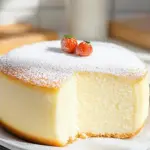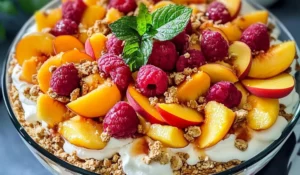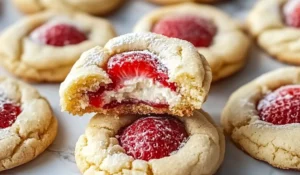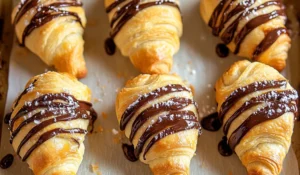Japanese cheesecake, also known as Japanese cotton cheesecake, is a cloud-like dessert that combines the best of both worlds—cheesecake and sponge cake. With its ultra-light and airy texture, this cheesecake stands in stark contrast to the classic dense, heavy versions we’re used to. It’s mildly sweet, slightly tangy, and incredibly creamy, creating a harmonious balance of flavors and textures that melt in your mouth with each bite.
PrintJapanese Cheesecake: A Fluffy, Jiggly Delight
Japanese cheesecake, also known as Japanese cotton cheesecake, is a cloud-like dessert that combines the best of both worlds—cheesecake and sponge cake. With its ultra-light and airy texture, this cheesecake stands in stark contrast to the classic dense, heavy versions we’re used to. It’s mildly sweet, slightly tangy, and incredibly creamy, creating a harmonious balance of flavors and textures that melt in your mouth with each bite.
- Prep Time: 15 minutes
- Cook Time: 1 hour 20 minutes
- Total Time: 1 hour 35 minutes
- Yield: 8 servings (one 8-inch cheesecake) 1x
- Category: Dessert
- Method: Baking
- Cuisine: Japanese
- Diet: Vegetarian
Ingredients
For the Cheesecake:
- 6 large eggs (separated): The eggs are a key ingredient in the light and fluffy texture of the cheesecake. The yolks are mixed into the cream cheese mixture, while the whites are whipped into a meringue, which is then folded into the batter.
- 8 ounces cream cheese (softened): Use good-quality cream cheese for a smooth, creamy texture that forms the base of the cheesecake.
- ¼ cup heavy cream: The addition of cream adds richness to the cheesecake while maintaining a smooth consistency.
- 4 tablespoons unsalted butter (cut into smaller pieces): The butter is melted into the cream cheese mixture, contributing to the rich texture.
- ½ cup cake flour (fluffed, spooned, and leveled): Cake flour is finer and lighter than all-purpose flour, which helps in achieving the fluffy texture of the cheesecake.
- 1 tablespoon lemon zest (optional): Lemon zest adds a hint of citrus that brightens up the cheesecake without overpowering its flavor.
- 1½ teaspoons vanilla extract (optional): For a subtle vanilla flavor that complements the cheesecake’s delicate taste.
- ⅓ cup granulated sugar: This sweetens the meringue and the cream cheese mixture. The sugar helps in stabilizing the meringue when whipping the egg whites.
- 2 teaspoons lemon juice (optional): Adds a touch of acidity to balance the sweetness and enhances the flavor of the cream cheese.
Optional Toppings:
- Powdered sugar: A light dusting of powdered sugar on top adds a delicate sweetness and finishes off the cheesecake beautifully.
- Apricot jam (for glazing): A thin layer of apricot jam brushed on top of the cheesecake gives it a glossy finish and a touch of sweetness.
- Berries: Fresh berries like strawberries, raspberries, or blueberries can be added for a burst of freshness and color.
- Sweetened whipped cream: A dollop of whipped cream complements the lightness of the cheesecake and adds a creamy texture.
Instructions
Prepare the Equipment
- Preheat your oven to 300°F (150°C).
- Line the bottom of an 8-inch round cake pan with parchment paper. Grease the sides of the pan. Prepare a 9×9 inch baking pan for the water bath (this will help maintain moisture during baking).
Make the Base Batter
- Heat the cream cheese mixture: Place the cream cheese, butter, and heavy cream in a large heatproof bowl. Set the bowl over a pot of simmering water, making sure the bowl doesn’t touch the water. Heat and whisk the ingredients together until smooth and combined.
- Add the egg yolks: Once the cream cheese mixture is smooth, add the egg yolks and whisk until everything is well incorporated.
- Sift the dry ingredients: Sift the cake flour into the mixture and whisk until no lumps remain. Set the mixture aside to cool. You can add lemon zest and vanilla at this point, then set the mixture aside to cool.
Prepare the Meringue
- In a clean bowl, add the egg whites and lemon juice. Using a hand mixer, start whipping the egg whites on medium-high speed until frothy.
- Gradually add the granulated sugar to the egg whites, a third at a time, until soft peaks form.
- Continue whipping until you achieve medium-soft peaks. The meringue should be stable but not too stiff.
Combine the Batter and Meringue
- Take ⅓ of the meringue and fold it gently into the cream cheese mixture. This will help lighten the batter.
- Add the rest of the meringue in two more parts, folding gently each time until no streaks remain.
Bake the Cheesecake
- Pour the batter into the prepared cake pan. Tap the pan firmly on the counter to release any large air bubbles.
- Place the cake pan into the 9×9 baking pan filled with hot water, and bake for about 80-90 minutes. The cheesecake should be golden brown on top and firm to the touch, with a skewer inserted in the center coming out clean.
- Once done, carefully remove the cheesecake from the oven. Let it cool for a few minutes, rotating the pan every 20-30 seconds to release it from the pan.
Cool and Serve
- After cooling for a few minutes, flip the cheesecake onto a plate and remove the parchment paper. Let it cool completely.
- Dust the top of the cheesecake with powdered sugar or brush with apricot jam for a glossy finish. Serve it with fresh berries or whipped cream, if desired.
Notes
- Egg whites: It’s important to whip the egg whites until they reach the correct stage. Soft peaks will allow the cake to rise, creating the fluffy texture. If the peaks are too stiff, the cheesecake might not rise properly.
- Water bath: Be sure the water bath doesn’t splash into the cheesecake pan. You can wrap the outside of the cake pan with foil to prevent any water leakage.
- Oven temperature: Japanese cheesecakes can be sensitive to temperature changes. Make sure to bake at a low temperature, as higher heat can cause cracks or deflate the cake.
- Chilling: The cheesecake can be served warm or after it has chilled in the fridge for at least an hour. Chilling helps set the texture and makes the cake easier to slice.
What sets this dessert apart is its ethereal, jiggly consistency, which is a result of the delicate folding technique and the use of meringue. It’s a showstopper for any occasion, from casual get-togethers to special celebrations. If you’re someone who loves cheesecake but finds the traditional versions too rich, this lighter, fluffier alternative will win you over.
This recipe for Japanese cheesecake takes you step by step through the process, with helpful tips and photos to guide you in creating the perfect jiggly cheesecake that is as pleasing to the eyes as it is to the palate.
Why You’ll Love Japanese Cheesecake
- Light and Fluffy: The texture of this cheesecake is what makes it so special. It’s incredibly light and airy—more like a souffle or chiffon cake than the dense American cheesecake.
- Mildly Sweet: The flavor of Japanese cheesecake is not overwhelmingly sweet. It strikes a balance, with subtle notes of tanginess from the cream cheese and the refreshing brightness of lemon.
- Versatile: While delicious on its own, you can also top this cheesecake with your favorite fruits, whipped cream, or a light glaze for added flavor and decoration.
- Impressive Presentation: The jiggly texture and soft golden top make for a striking presentation, sure to impress your guests.
Ingredients Breakdown
For the Cheesecake:
- 6 large eggs (separated): The eggs are a key ingredient in the light and fluffy texture of the cheesecake. The yolks are mixed into the cream cheese mixture, while the whites are whipped into a meringue, which is then folded into the batter.
- 8 ounces cream cheese (softened): Use good-quality cream cheese for a smooth, creamy texture that forms the base of the cheesecake.
- ¼ cup heavy cream: The addition of cream adds richness to the cheesecake while maintaining a smooth consistency.
- 4 tablespoons unsalted butter (cut into smaller pieces): The butter is melted into the cream cheese mixture, contributing to the rich texture.
- ½ cup cake flour (fluffed, spooned, and leveled): Cake flour is finer and lighter than all-purpose flour, which helps in achieving the fluffy texture of the cheesecake.
- 1 tablespoon lemon zest (optional): Lemon zest adds a hint of citrus that brightens up the cheesecake without overpowering its flavor.
- 1½ teaspoons vanilla extract (optional): For a subtle vanilla flavor that complements the cheesecake’s delicate taste.
- ⅓ cup granulated sugar: This sweetens the meringue and the cream cheese mixture. The sugar helps in stabilizing the meringue when whipping the egg whites.
- 2 teaspoons lemon juice (optional): Adds a touch of acidity to balance the sweetness and enhances the flavor of the cream cheese.
Optional Toppings:
- Powdered sugar: A light dusting of powdered sugar on top adds a delicate sweetness and finishes off the cheesecake beautifully.
- Apricot jam (for glazing): A thin layer of apricot jam brushed on top of the cheesecake gives it a glossy finish and a touch of sweetness.
- Berries: Fresh berries like strawberries, raspberries, or blueberries can be added for a burst of freshness and color.
- Sweetened whipped cream: A dollop of whipped cream complements the lightness of the cheesecake and adds a creamy texture.
Step-by-Step Instructions
Prepare the Equipment
- Preheat your oven to 300°F (150°C).
- Line the bottom of an 8-inch round cake pan with parchment paper. Grease the sides of the pan. Prepare a 9×9 inch baking pan for the water bath (this will help maintain moisture during baking).
Make the Base Batter
- Heat the cream cheese mixture: Place the cream cheese, butter, and heavy cream in a large heatproof bowl. Set the bowl over a pot of simmering water, making sure the bowl doesn’t touch the water. Heat and whisk the ingredients together until smooth and combined.
- Add the egg yolks: Once the cream cheese mixture is smooth, add the egg yolks and whisk until everything is well incorporated.
- Sift the dry ingredients: Sift the cake flour into the mixture and whisk until no lumps remain. Set the mixture aside to cool. You can add lemon zest and vanilla at this point, then set the mixture aside to cool.
Prepare the Meringue
- In a clean bowl, add the egg whites and lemon juice. Using a hand mixer, start whipping the egg whites on medium-high speed until frothy.
- Gradually add the granulated sugar to the egg whites, a third at a time, until soft peaks form.
- Continue whipping until you achieve medium-soft peaks. The meringue should be stable but not too stiff.
Combine the Batter and Meringue
- Take ⅓ of the meringue and fold it gently into the cream cheese mixture. This will help lighten the batter.
- Add the rest of the meringue in two more parts, folding gently each time until no streaks remain.
Bake the Cheesecake
- Pour the batter into the prepared cake pan. Tap the pan firmly on the counter to release any large air bubbles.
- Place the cake pan into the 9×9 baking pan filled with hot water, and bake for about 80-90 minutes. The cheesecake should be golden brown on top and firm to the touch, with a skewer inserted in the center coming out clean.
- Once done, carefully remove the cheesecake from the oven. Let it cool for a few minutes, rotating the pan every 20-30 seconds to release it from the pan.
Cool and Serve
- After cooling for a few minutes, flip the cheesecake onto a plate and remove the parchment paper. Let it cool completely.
- Dust the top of the cheesecake with powdered sugar or brush with apricot jam for a glossy finish. Serve it with fresh berries or whipped cream, if desired.
Tips and Troubleshooting
- Egg whites: It’s important to whip the egg whites until they reach the correct stage. Soft peaks will allow the cake to rise, creating the fluffy texture. If the peaks are too stiff, the cheesecake might not rise properly.
- Water bath: Be sure the water bath doesn’t splash into the cheesecake pan. You can wrap the outside of the cake pan with foil to prevent any water leakage.
- Oven temperature: Japanese cheesecakes can be sensitive to temperature changes. Make sure to bake at a low temperature, as higher heat can cause cracks or deflate the cake.
- Chilling: The cheesecake can be served warm or after it has chilled in the fridge for at least an hour. Chilling helps set the texture and makes the cake easier to slice.
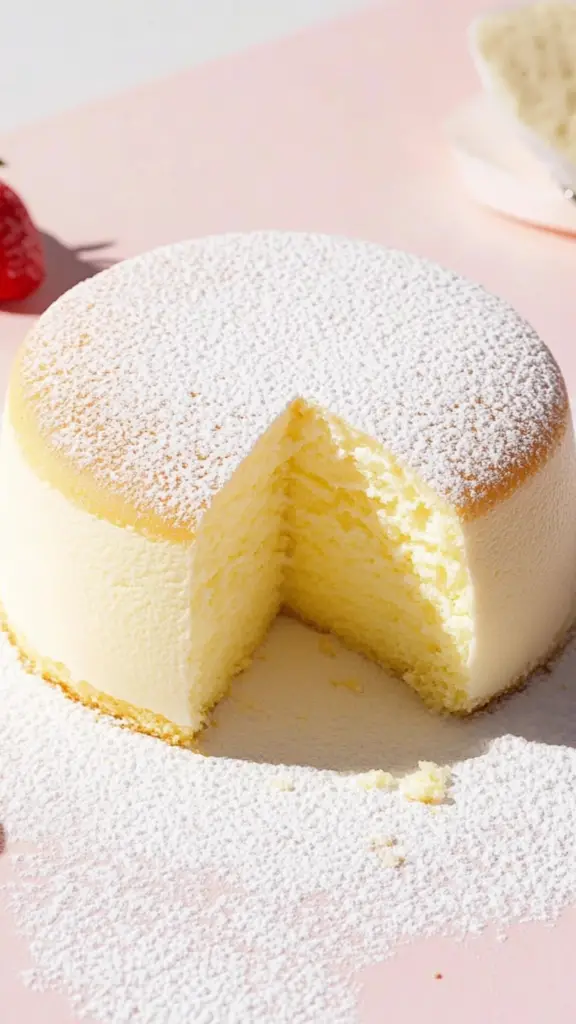
Conclusion
Japanese cheesecake is the perfect dessert for anyone who loves cheesecake but craves something lighter, fluffier, and less sweet. With its delicate texture, subtle sweetness, and delightful tang, it’s an impressive treat that will surely wow your guests. The process might seem a bit intricate, but with the detailed steps and helpful tips, you’ll have a perfect cheesecake every time. Whether you enjoy it plain, with a simple dusting of powdered sugar, or topped with berries and whipped cream, this cheesecake is sure to become a favorite in your dessert repertoire.
Enjoy the process of making this stunning cake and relish the jiggly, melt-in-your-mouth results!

